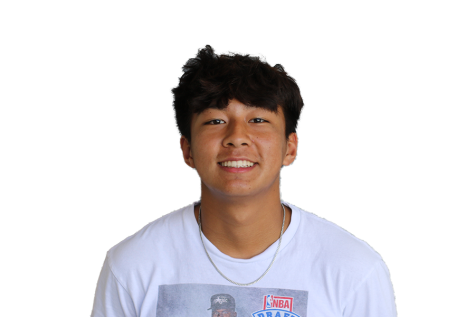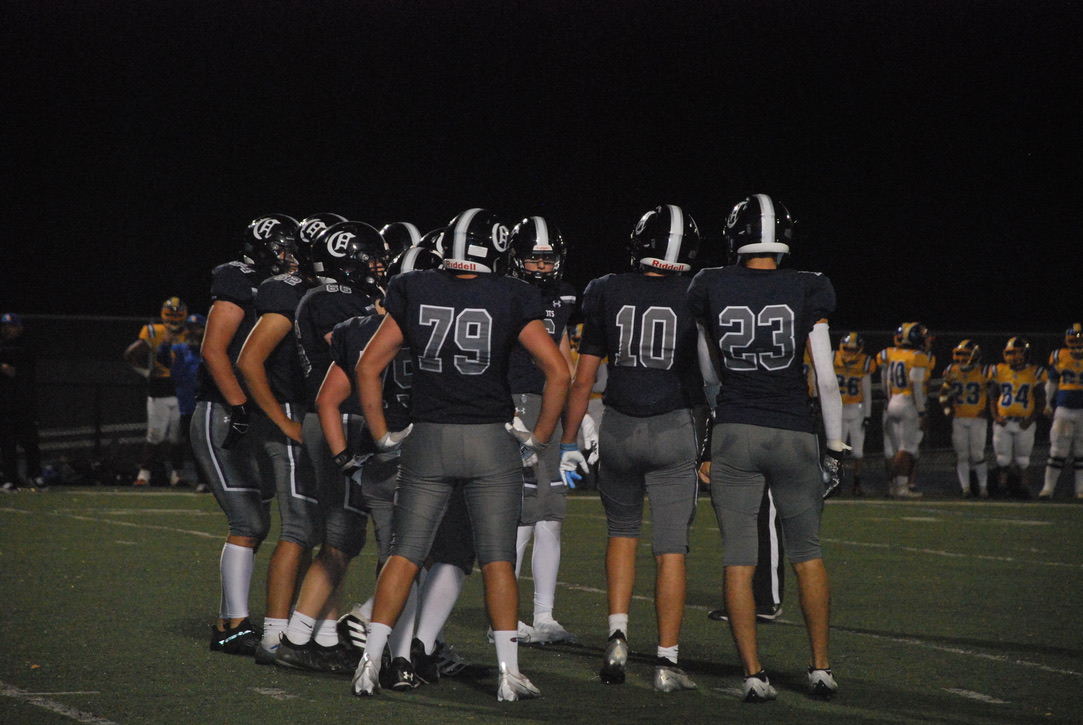
Instagram and Twitter: @avstinli

Twitter: @soleildam


October 30, 2022
After a hard-fought victory over a neighboring school, Ivan Coronel returned to the locker room with his team. They yell and chant, rejoicing over winning the final game of their season. Half an hour passes, and the team finally settles down, Coronel now near his respective locker.
His elation is short-lived.
The thought hits Coronel like a freight train as he loosens his pads: this was the last time he’d ever play on Terry Stogner Field, decked in blue and white. The finality of it all makes his heart sink, and tears follow quickly.
Like Coronel, 93% of football players’ careers will end after their final varsity game.
For the 7% who continue on, many think passionate fans, massive stadiums, and national television broadcasts epitomize the remainder of their careers. True, these are all defining characteristics that make football the dominant collegiate sport. But behind the glory and fame lies the blood, sweat, and tears required to gain entry into the lucrative limelight.
Prospects don’t simply play and hope some coaches reach out to them. The recruiting process requires a concentrated effort from both ends.
It’s cutthroat.
And it’s also obscure. Most high school players have no idea how the process works or how to even begin to be recruited.
Thus, below is an athlete’s guide to football recruiting.
The recruitment process for football begins when an athlete is recognized for their outstanding physical and mental capabilities, the characteristics that distinguish them from other players. Although this process can start as early as eighth grade, most players begin during high school when they experience the most physical and athletic growth. Consequently, the jump from high school to college football crushes the dreams of most hometown football heroes. According to the National Collegiate Athletic Association (NCAA), only 6.5% of players will continue in college, 2.5% being Division I prospects.
Does this mean the other 93% of players aren’t great athletes? Not at all. Consider this. Current statistics show over 1,000,000 high school football players in the United States, meaning the average player barely breaks the 87th percentile in terms of athletic ability. As a result, it’s no surprise that even the largest and most successful high schools may go years without producing a single Division I prospect. At the end of the day, the sad truth is that only the top athletes will even be considered by college recruits. Their job is to simply lock down the best players to create the most dominant teams.
However, for student-athletes confident in their ability to make this transition, there are multiple ways to maximize their chances of being recruited.
The best way to jumpstart the recruiting process is to utilize social media platforms such as Twitter and Instagram to reach out and send film to coaches. With over 1 million players nationwide, it’s almost impossible for recruits to look at and analyze each one. As a result, it’s imperative that players constantly email or direct message coaches to put a foot in the door and demonstrate their eagerness to attend certain schools.
Just take Josh Allen, for example. Arguably one of the most talented quarterbacks in today’s NFL, Allen came from humble beginnings. He was born and raised on a cotton farm in Firebaugh, Calif., and played for a small school. Allen had no offers and was on no recruit’s radar entering his senior year. Nevertheless, he refused to give up, sending over 1,000 emails to every single Division I head coach, offensive coordinator, and quarterbacks coach in the country. Only two schools would end up offering Allen a spot, after which he committed to the University of Wyoming.
Although the majority of players won’t go on to play for the NFL, Allen’s story is a prime example of how pivotal continuously contacting recruiters can be.
Another example is John Chung, a current safety at Sacred Heart Preparatory in Atherton, Calif. Chung started playing tackle football when he was just seven years old. While on the Menlo Atherton Vikings, he knew he would be in for the long run.
“I played pop warner up until eighth grade for the Vikings and always just wanted to play football for as long as possible,” Chung said.
Later starting on varsity as a nickelback his sophomore year, Chung gained a good amount of film and sent it to various schools. Although none of the schools responded, this only pushed Chung to work harder the following year and continue reaching out to coaches. Ultimately, his hard work paid off. Later that year, Chung received an offer from Harvard University and will be continuing his career with the Crimson next fall.
Just put your name out there and show a lot of interest because if you market yourself as someone who’s genuinely interested in the school, then that puts you a lot higher up on their board. It’s definitely important to be proactive, reaching out to coaches and just doing as much as you can to get noticed
— John Chung
It’s also vital that players contact coaches early on, something most athletes don’t know to do. Even if the film sent isn’t spectacular or long, it shows demonstrated interest in specific football programs. By beginning the process as a sophomore, players can be added to recruiters’ watch lists and show development over the years. Waiting until your final year to start reaching out is risky as many schools may already have committed players by then.
“Something I really regret is not starting the [football] recruiting process earlier. Football has really become something that I love and want to pursue in the future. I just wish I knew to contact and send film to coaches during my sophomore and junior years,” said Trevor Johnson, a current senior on Carlmont’s varsity football team.
That being said, players should still try their hand at recruitment, even if it’s their final season. In Johnson’s case, he reached out to coaches and, in two weeks, received responses from Division II schools such as the University of Wisconsin-Whitewater.
Obviously, to become a college prospect, athletes must already have immense athleticism and talent. However, continuously contacting coaches proves to be a very effective way to further separate yourself from other players.
“There are probably over 10,000 players trying to get recruited to these schools, so the best thing to do is to just actively use social media. Just put your name out there and show a lot of interest because if you market yourself as someone who’s genuinely interested in the school, then that puts you a lot higher up on their board. It’s definitely important to be proactive, reaching out to coaches and just doing as much as you can to get noticed,” Chung said.
Aside from talking to coaches through social media, attending football camps is the next best way for players to get noticed. Essentially, football camps and combines are sessions organized by colleges. They allow coaches to properly assess a player’s athletic ability while also evaluating their personality, intelligence, and work ethic. In addition, these camps serve as an excellent way for athletes to find which college programs are best suited for them.
“One thing all the coaches said was how much they really wanted to see players at camps, so I attended one at Harvard,” Chung said. “After I went through the testing, measurables, and various competitive drills, they pulled me and three other guys aside and invited us to have lunch with the head coach.”
The best camps to attend for college attention are one-day college football camps where players are put through various drills and one-on-one sessions. Oftentimes, recruiting and position coaches from all over the nation will be in attendance, so it’s one of the best ways to gain exposure. Here in the Bay Area, Stanford and the University of California, Berkeley, are notable universities that offer one-day camps.
Casey Oliveira, a former teammate of Chung and a current safety on Carlmont’s varsity football team, was recruited to Carleton College primarily due to his success at a one-day camp organized at Dartmouth College.
“After competing in team drills and showing out during seven on sevens, the [Carleton] coaches approached me after the practice just telling me they liked my play and wanted to invite me for an unofficial visit,” Oliveira said.
Although using social media is a great way to get attention, highlight reels and film can only show so much to coaches. They want to see how players will perform in person.
The final way to increase the chances of recruitment is to utilize the resources you have around you. There is a common misconception that football recruiting is solely carried out by college coaches or specialist recruiters. However, what most athletes don’t realize is that the high school coaches around them play a significant role in the recruitment process. In fact, according to the NCAA, high school coaches are more responsible for football recruits than all college recruiting personnel combined.
The reasoning behind this is that experienced high school coaches spot potential prospects as early as eighth grade and can then use their connections and platform to get their players’ names across. They also help players decide which division or school may be best for them and walk them through the recruiting process.
“One of my football coaches actually introduced the possibility of college football to me. [Coach Berry] then helped me create a list of target schools to reach out to, decide what film to send out, and even helped me edit my emails to certain coaches,” Johnson said.
Chung’s coach also played a similar role in his recruitment to Harvard.
“Coach Grieb really helped me during the recruiting process. Not only did he put things into perspective, but he also talked to coaches and put in a good word for me. I’m just really grateful for everything he did,” Chung said.
Ultimately, recruiters aren’t solely looking for players with ideal intangibles such as height and weight. Although this may help as eye candy, they also care about a player’s work ethic, personality, and relationship with their current coaches. Thus, college coaches will pepper a prospect’s high school coach with questions to find qualities that don’t show up on film.
So there you have it, an athlete’s guide to football recruitment. At the end of the day, you don’t have to be a 6-foot-3, 250-pound linebacker to play college football. However, eager athletes must be willing to put in extensive amounts of effort. By excelling and placing their best foot forward inside the classroom and on the field, high school athletes can optimize their chances of making it to the next level.

